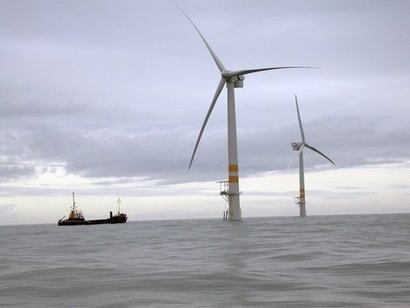
The data, drawn from BNEF’s world-leading database of deals and projects, show that one sub-sector of renewables – offshore wind – had by far its busiest half year ever for final investment decisions, and this more than offset declines in investment in solar, onshore wind and biomass.
Offshore wind financings in 1H 2020 totaled $35 billion, up 319 percent year-on-year and in fact well above 2019’s record full-year figure (a revised $31.9 billion). The first half of this year saw investment decisions made on 28 sea-based wind farms, including the largest ever, the 1.5 GW Vattenfall Hollandse Zuid array off the coast of the Netherlands, costing an estimated $3.9 billion.
Other major offshore deals included the 1.1 GW SSE Seagreen project off the U.K., at an estimated $3.8 billion; the 600 MW CIP Changfang Xidao array off Taiwan, at an estimated $3.6 billion; and the Fecamp and Saint-Brieuc projects in French waters, together totaling 993 MW and $5.4 billion. There were no fewer than 17 Chinese installations financed, led by the Guangdong Yudean Yangjiang Yangxi Shapaat 600 MW and $1.8 billion.
“We expected to see Covid-19 affecting renewable energy investment in the first half, via delays in the financing process and to some auction programmes” said Albert Cheung, head of analysis at BNEF. “There are signs of that in both solar and onshore wind, but the overall global figure has proved amazingly resilient – thanks to offshore wind.”
Tom Harries, head of wind analysis, added that offshore wind is benefitting from the 67 percent reduction in levelised costs achieved since 2012, and from the performance of the latest, giant turbines. However, the first half of this year also owed a lot to a rush in China to finance and build, in order to take advantage of a feed-in tariff before it expires at the end of 2021.
Mr Harries said he is expecting a slowdown in offshore wind investment globally in the second half, with potentially a new spike early next year.
Overall investment in new renewable energy capacity (excluding large hydro-electric dams of more than 50 MW) was $132.4 billion in the first half of 2020, up 5 percent from a revised $125.8 billion in the same period of 2019. Onshore wind investment slipped 21 percent to $37.5 billion, while that for solar fell 12 percent to $54.7 billion.
Investment in new biomass and waste-to-energy plants fell 34 percent to $3.7 billion, while that in geothermal jumped 594 percent to $676 million. Small hydro projects of less than 50 MW attracted an estimated $576 million, down 14 percent, and biofuel production plants $250 million, down 82 percent.
Looking at the figures by location, China was the largest market yet again, investing $41.6 billion in 1H 2020, up 42 percent compared to the same period in 2019 thanks to its offshore wind boom. Europe secured $36.5 billion, up 50 percent, while the US slipped 30 percent to $17.8 billion. Japan saw financings rise 14 percent to an estimated $10.8 billion, but India fell 49 percent to $2.7 billion and Brazil was down 26 percent at $2.5 billion. The Netherlands were up 231 percent at $6.9 billion, France up 306 percent at $6.2 billion, the U.K. 265 percent higher at $5.7 billion, Spain down 11 percent at $3.7 billion, and Germany up 20 percent at $3.6 billion.
Angus McCrone, chief editor at BNEF, said that a clearer picture of the impact of Covid-19 on green energy investment will come with the full-year 2020 figures.
“Renewables have been helped by vastly improved competitiveness and by investor appetite for assets offering secure cash flows” Mr McCrone said. “However, project developers face the challenge that key people, whether at the permitting, financing or construction stages, can’t meet face-to-face. And buyers of small-scale solar systems are sensitive to changes in consumer confidence.”
BNEF’s data for corporate-level investment in renewables and energy-smart technologies such as battery storage show that equity raising by specialist companies on public markets was $2.4 billion in the first half of 2020, down 43 percent. Investment from venture capital and private equity funds was up 10 percent at $2.5 billion.
The biggest deals on public markets were initial public offerings by two Chinese solar companies, Jinko Power Technology and Trina Solar, raising $366 million and $359 million respectively. The top ones in VC/PE were private equity expansion round for Altus Power America, a US solar project developer, totaling $850 million; and a PE round of $300 million for Scale Microgrid Solutions, a US company putting together energy systems involving solar and batteries.
Overall clean energy investment, including renewables capacity financing and corporate-level equity deals, came to $137 billion in the first half of 2020, up 4 percent on 1H 2019’s $131.9 billion.
For additional information:

